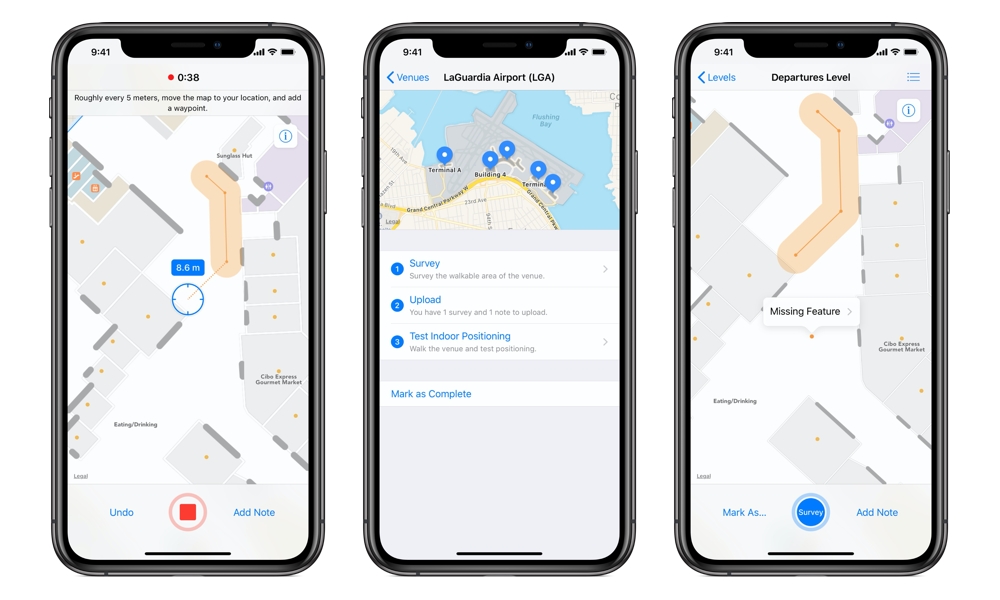Apple Just Updated This App You’ve Never Heard of in Preparation for the iPhone XI
 Credit: Apple
Credit: Apple
Toggle Dark Mode
Apple has just released a pretty big update to an app that you’ve probably never heard of, and it’s adding more credibility to rumours that this year’s iPhones will include a revolutionary new indoor navigation system.
Almost four years ago, Apple quietly released a new app called Indoor Survey, designed to allow businesses to map out their indoor venues and collect location data based on the strength of nearby Wi-Fi and Bluetooth signals. This data could then be incorporated into apps that want to track an iPhone user’s position within stores, shopping malls, airports, stadiums, and even hospitals.
While the original purpose of Indoor Survey was to create maps for use with Apple’s “iBeacon” Bluetooth-enabled fixtures, it’s not difficult to see how this could also tie into the more sophisticated indoor navigation systems that are rumoured to be coming to Apple’s slate of 2019 iPhones.
Indoor Positioning using iBeacons
Standard outdoor navigation, such as finding directions on the road, rely on the Global Satellite Positioning (GPS) system, which, as the name implies, uses satellites. Sadly, while GPS works pretty well outdoors — and Apple has taken steps to augment its accuracy even further with cellular and Wi-Fi positioning — it’s generally difficult, if not impossible, to get a fix on GPS satellites when you don’t have a clear, unobstructed line of sight to the sky.
When indoors, your iPhone will instead fall back to Wi-Fi positioning — checking the strength of nearby Wi-Fi access points in order to gauge your approximate location. However, this doesn’t offer any real degree of accuracy; nearby Wi-Fi access points might be able to tell you that you’re inside a mall, for example, and perhaps even which end of the mall you’re at, but they won’t often be enough by themselves to tell you what store you’re standing in front of, and definitely can’t navigate you to a specific place.
Apple’s original answer to this was in the form of iBeacons — sets of Bluetooth beacons that would help pin down a user’s position more precisely. Since Bluetooth has lower range than Wi-Fi, it’s easier for your iPhone to figure out where it is by looking at which beacons are in range. The downside to iBeacons, of course, is that venues have to take the trouble to install them, and then use Apple’s Indoor Survey app to actually walk around their venue to collect data that can be used to build a map of where the beacons are located. It’s an inefficient and expensive process, and it requires a level of commitment on the part of business owners that many understandably can’t be bothered with.
Indoor Navigation
Not surprisingly, it looks like Apple has a bigger and better plan up its sleeve, with rumours that it’s equipping its 2019 iPhones for full indoor navigation — features that would not just allow your iPhone to figure out where you are, but also provide enough data to actually take you, step-by-step, from point A to point B.
The feature is based on a new technology called Ultra-wideband (UWB), which is a short-range radio infrastructure that’s specifically designed for precise indoor positioning to make up for the lack of GPS coverage. UWB, when properly deployed, promises a complete blanket of coverage everywhere in the store, with no dependency on strategically placing individual beacons or other transmitters around the store itself. Even better, it can peg your location down to a four-inch radius.
While this year’s iPhone would only provide half of the puzzle in the form of UWB receivers, requiring actual venue operators to install the necessary transmitters, it’s easy to see how this is an “if-you-build-it-they-will-come” scenario — once there are millions of iPhones in users’ hands capable of using UWB indoor navigation, this will kickstart business owners to start deploying the technology, in much the same way that contactless payments took off in the U.S. after the launch of Apple Pay.
The Indoor Survey app
While the newly updated Indoor Survey app doesn’t make any specific mention of UWB, of course, the fact that Apple is giving it such a big update only weeks before it’s expected to release new UWB-equipped iPhones seems like more than a coincidence, and in the very least signals a bigger push into indoor positioning on Apple’s part. The new version not only sports an entirely new design that will make it faster and easier to use, coaching users through the process, but also now offers the ability to add map notes, and opens up support for the more open Indoor Mapping Data Format (IMDF) that should allow data to more easily be exchanged with other indoor location apps.






